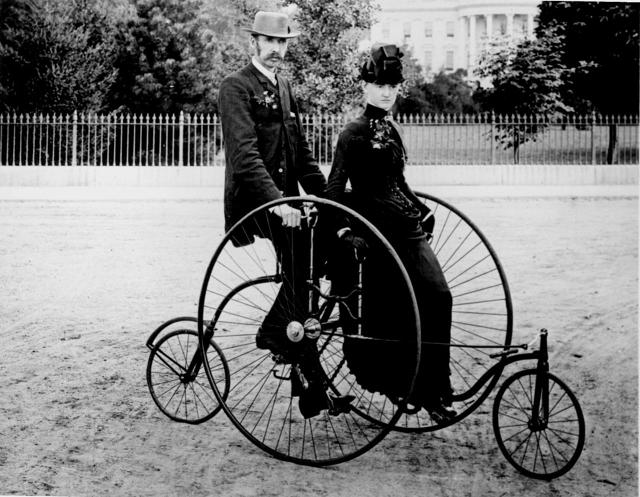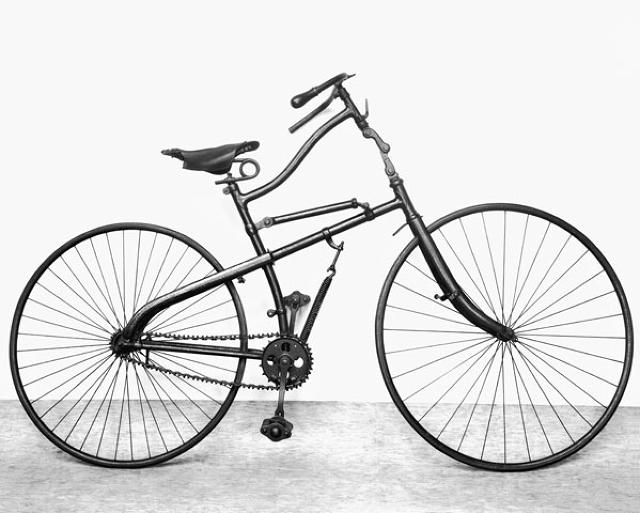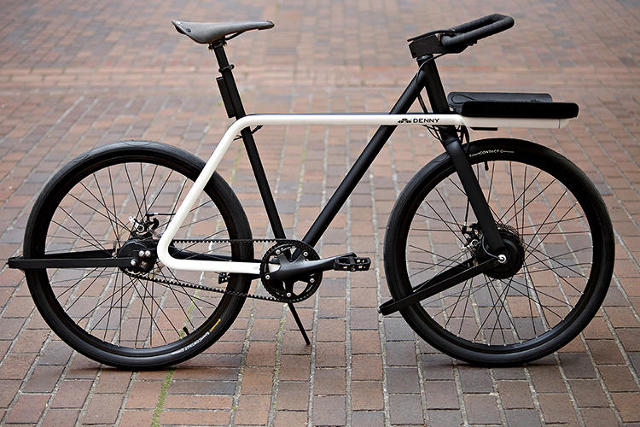The bicycle hasn’t changed much since the 1890s: Today’s version has the same basic diamond shape and the same configuration of parts that it’s had for over 100 years. If a 19th-century cyclist time-traveled to 2015 and got on your Bianchi, he’d know what to do.
You could argue that the bike has lasted so long because it has a nearly perfect design. In part, that’s because the bicycle craze of the 1800s spawned so many new ideas and inventions. At one point, an entire patent office—out of two that existed in the U.S.—was devoted entirely to inventions for bicycles.
After experiments with different shapes and styles of bikes, like velocipedes with giant front wheels, designers finally landed on consensus with the basic design we know today. “The real reason bikes seem so similar today to bikes of yesteryear is because they nailed the design back then,” says Jim Langley, a former technical editor for Bicycling Magazine.
“From around 1817 to 1890, there was an unprecedented amount of experimentation, thought and invention put into the bicycle,” he says. “At that time it was the most amazing invention known and the entire world focused on improving it. You could argue that no item since the bicycle back in the 1890s received so much attention from the world’s top scientists, inventors and dreamers.”
From our partners:
But that hasn’t stopped modern-day designers from trying to make a bicycle better-suited for modern city life. The original cyclists shared roads with horse-drawn carriages, not speeding two-ton cars. They didn’t try to carry bikes on subways. New bike designs are tackling the issues of 2015, at the same time that infrastructure for bikes quickly improves. The bicycle may be on the verge of becoming ideally suited for urban commuters in today’s world.

On a part-by-part, problem-by-problem scale, innovations keep accelerating. To tackle the ongoing challenge of bike theft, for example, designers have come up with everything from smart bike pedals that track a stolen bike through GPS to a bike frame that converts into a lock.
Smart technology built into helmets—and maybe soon into other parts of a bike frame—can now communicate with equipped cars to warn both cyclists and drivers before a potential crash. Some car manufacturers, like Jaguar, are also building systems that can automatically detect cyclists without any additional tech on the bike. Dutch designers are experimenting with airbags that would be mounted outside cars to protect cyclists if a crash can’t be avoided.
To make commuting by bicycle easier, folding bikes keep getting smaller and simpler to squeeze on the subway or in a corner of the office when you arrive at work. One new design for an electric bike can fold up so completely that it fits inside a backpack. Another folds at the push of a button, so riders don’t have to deal with several steps of disassembly. Better electric motors make it easier for commuters to go longer distances without a sweat. New navigational systems buzz handlebars for every turn, so riders don’t have to look down at a map.

Some designs have attempted to combine as many of these new features as possible into the ultimate urban bike, targeted at casual riders who would otherwise drive. In Oregon Manifest’s Bike Design Challenge last year, the winning design, called the Denny, has built-in head and tail lights that automatically brighten when it gets dark, turn signals, a brake light, and LED lights that project a bike lane onto darkened streets.
The handlebar turns into a sturdy U-lock, so you don’t have to carry an extra with you. Electric assist and automatic gears make it easy to ride even in a hilly city.
Is the Denny’s design enough to truly challenge a car for convenience? Perhaps not yet—but the more attention focuses on improving the bike—and the more cities are designed to not favor automobile transportation—the closer we get to that possibility.
“We are very, very close, and in some cases already there,” says Shannon Holt from Oregon Manifest. “The Denny gets us in the zone, and cities will continue to meet us closer to halfway. As more of us return to the urban core, dealing with a car is becoming less and less attractive. Riding a bike, on the other hand is starting to make more and more sense to the average citizen for short or medium trip—it’s less expensive, it’s not subject to traffic congestion in the ways that cars are and it doesn’t require a search for a parking space.”
When most car trips are shorter than three miles, it may already be more convenient to ride a bike, Holt says. A better design may be what it takes to convince more commuters of that fact. “Offering more amenities in a bike design and therefore in the experience of cycling itself, encourages the average car-driver to reconsider their options,” she says.

And, of course, it isn’t just the bike itself that needs to evolve—so do cities. “We do need a better or different bike,” says Colin Owen, who teaches bike design at California College of the Arts and founded an urban cycling brand called Sparse. “However, bikes are a mature technology. The less-than-optimal aspects of bicycles are not ‘the problem.'”
“The more fundamental roadblocks in the U.S. are all the externalities around cycling,” he says. “Roadways are unprotected, bike storage may be insecure or non-existent or it may be up five stories in a walkup. You may not have access to a shower at work, maybe your commute is beyond a distance in which it’d be reasonable to pedal.”
Those things need to change, Owen argues, as much as the physical object of the bike. Luckily, some of that change is starting to happen. Protected bike lanes, for example, have quadrupled in the U.S. since 2010.
And as more and more designers focus on optimizing bike design—while better infrastructure grows—the bicycle may soon be ideally suited for city use. That doesn’t mean the design won’t change again.
“The concept of perfection is constantly unrolling,” says Holt. “A perfect bike that melds seamlessly into today’s technological and urban lifestyle will doubtlessly want for some upgrades in the future. In essence, all product design is temporary in its perfection—bikes are no exception—so the perfect form of human-powered transportation is completely transient.”
This feature is adapted from Fast Company
















